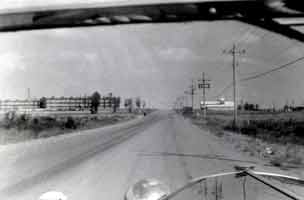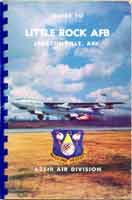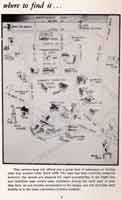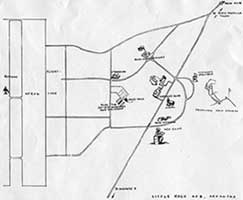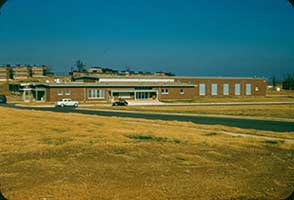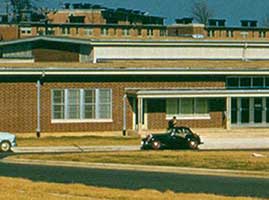From
the LRAFB "Guide to . . .", a cartoon map.* The
single photo view at the top of this page is marked with a <.
Points of interest are marked in blue on the map, orange,
orange here. The line drawing was scanned and sent by Joe Hnat. It shows our barracks
location, and a few others, more explicitly. In the linked big view it is rotated
to correspond more closely with the view of the Guide map, making them both roughly
North-to-top.
From the top:
I may have been confused by the driveways
in front of the 70th Wing Headquarters building when
I put the 70 RTS new building on the side of the maintenance area, rather than
on 2nd Street. The headquarters is where I spent one night as a guard, locked
in a 9' x 9' room with the door to a top Top Secret safe, an Army cot and mattress,
and a .45 Automatic. No radio, no TV, no light switch. Several .45-size holes
in the walls
Any road, that was the place all the equipment loaded with
that big old forklift went to. I picked up the forklift at the Transportation
Area, where I passed the licensing test ("See that forklift?"
"Yes." "That's the one.") and drove it a couple-three miles
to the old, off-base photo lab building. In 30-degree weather. It had the steering
wheels under the seat, and the seat faced the wrong way, so you could drive it
"forward" if you didn't mind going very, very slow. Rear-wheel steering,
aside from being awkward, can be dangerously sudden at any speed. So I drove to
the Lab looking over my shoulder. When I got there I couldn't turn around, almost
couldn't get down off the thing. Having the Lab in the same building as the remainder
of the squadron eliminated the Weapons-Carrier Taxi-driver
detail.
When I spent a few weeks as a shelf-stocker in the Commissary
(Bldg. 1036, I think, near the bottom right) the
Warehouse was where we got the goods. We met at the
store at 2AM, made a list of needs, piled in a truck and headed out, making a
stop at the base-housing (north of the golf course) home of the near-retirement
Mess Sergeant in charge of the detail. He would go in his kitchen, where we could
see him chug a can of beer. Back in the truck he'd chug another on the way to
the warehouse. He'd nurse one or two while we picked the goods and packed the
truck, then we'd stop by home and he'd resupply for the trip to the store and
our shelf-filling time.
The shift was supposed to last from 2AM to 10AM,
but if we hustled and got the shelf-stocking and floor-cleaning done before the
day crew came on at 7AM or so, we could leave and they wouldn't have a chance
to find something else for us to do. Of course it all depended on someone giving
the Sarge a ride home.
I drew in the approximate location of the barracks
(OK, "dormitory") building I lived in.
It was second or third in a row of four or five there in that corner. Opposite
its lower right side was the chow hall, one of several in the area. When I find
some more pictures it may come clearer how all this fit together. It was from
the back stoop of the barracks that I watched the 101st Airborne on their daily
5:30 AM jog around the base. Within their ranks I saw fellow Torrance High alumnus
Bill Ohlert.
When I arrived at LRAFB it was the second day of a forty-day
stretch without sun, second day of a four-day ice storm. Harsh, for a Southern
California boy. Not only was the weather harsh, the ground between the barracks
and the commercial-entertainment area was composed of sharp-cornered fragments
of broken rock. Crossing that uneven ground to go to the Airmen's club, BX, bank,
theater, was daunting. The walk around on roads was long, long enough that we
walked the rocks.
The map shows
a golf course. I can't imagine calling the territory in that area a golf course,
even by the time I got through spending a few days picking rocks out of the supposed
fairways. Seems to me the underlying terrain was like the rock-hazard between
the barracks and commercial area, just a little more pulverized.

